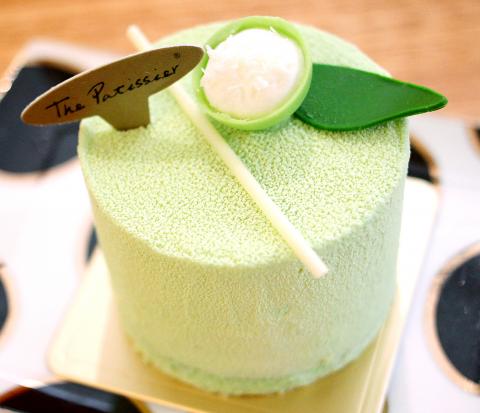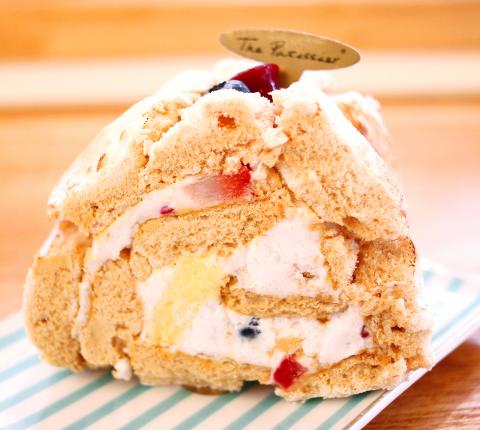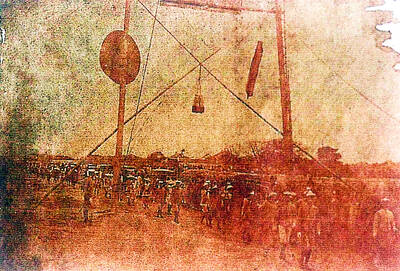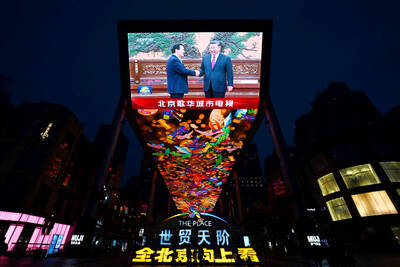What sweet outcomes can be achieved from a meeting of two countries? Politicians and diplomats can try to answer that question, but perhaps the best person to ask is a pastry chef on holiday.
When Singaporean pastry chef Liu Ming Kai (劉洺愷) vacationed in Taiwan, he ended up meeting his wife and planting the seeds of the first overseas location of The Patissier, which opens today.
While Singaporean eateries have made steady inroads into Taiwan in recent years — Ng Ah Sio Bak Kut Teh’s pork bone broth and Irvins Salted Egg snacks come to mind — The Patissier is a rare sweets specialist from the island nation. At home, the 19-year-old shop has built a loyal following around its innovations on classic French patisserie, adapting flavors and techniques unique to Singapore’s tropical setting.

Photo: Davina Tham, Taipei Times
Two successful pop-ups in Taipei in as many years convinced owners Chow Choon Kit (周俊傑) and Tan Siang Oon (陳湘筠) that there was a place for The Patissier here. Stars aligned last year when the couple learned that pop-up partner and now next-door neighbor, Furo Cafe, was downsizing to a takeaway-only space.
The result is a corner unit in the charming and affluent neighborhood of Siwei Road (四維路) in Daan District (大安). Customers can grab a coffee from Furo Cafe and carry it the few steps to The Patissier to sit and enjoy a slice of cake, while looking out on a quiet, bougainvillea-framed street.
After five years with The Patissier in Singapore, Liu has relocated to Taipei and leads the pastry team here. His immediate challenge was to translate the pastries, designed around Singapore’s year-round hot and humid weather, for Taiwan’s four seasons.

Photo: Davina Tham, Taipei Times
The Patissier’s signature pastry — a light meringue sponge filled with tart passionfruit mousse, fresh mangoes and strawberries — uses tropical fruits that in Taiwan are only available in the summer.
So for these colder months, Liu developed Smitten (NT$200 per slice), a meringue sponge filled instead with berry yogurt mousse, fresh strawberries and blueberries. A streak of passionfruit curd in the filling is essential, providing a nod to the original and an ambrosial hit of acidity. The meringue sponge is what makes this cake The Patissier’s calling card — the unusual airy, chewy crispness is a cross between a pavlova and a genoise.
Despite Taipei’s sophisticated pastry and confectionery scene, The Patissier may be one of the only shops in the city where you can get a croquembouche (NT$2,500 to NT$3,000) — a conical tower of choux puffs filled with pastry cream. While the show-stopping celebration confection is traditionally decorated with delicate spun sugar, the choux puffs in this version are dipped in chocolate, which does not melt as quickly. Brightly tinted chocolates, fondant decorations and the detachable choux puffs make for a terrifically kid-friendly, interactive dessert.

Photo: Davina Tham, Taipei Times
Two cake flavors have been developed exclusively for The Patissier’s Taipei branch. Be My Valentine (NT$200 per slice) pairs raspberry-milk chocolate mousse with raspberry jelly. Joyeux Apple (NT$200 per slice) comes cleverly shaped like a Granny Smith and faithfully contains green apple mousse, caramel filling and caramelized green apples, balancing sweet and sour with aplomb.
But a uniquely “Mod-Sin,” or modern Singaporean, take on dessert comes in the form of the Jade Mirror (NT$200 per slice), a composition of pandan, the vanilla of Southeast Asia, chiffon layered with kaya, a jam of pandan, coconut milk and eggs and soy milk mousse. The combination of these flavors, typical to a traditional Singaporean breakfast, is understated and seamless. As pandan leaves and kaya are almost impossible to find in Taiwan, Chow and Tan carried the ingredients over from Singapore, and the cake will be available until their stock runs out.

Photo: Davina Tham, Taipei Times

June 23 to June 29 After capturing the walled city of Hsinchu on June 22, 1895, the Japanese hoped to quickly push south and seize control of Taiwan’s entire west coast — but their advance was stalled for more than a month. Not only did local Hakka fighters continue to cause them headaches, resistance forces even attempted to retake the city three times. “We had planned to occupy Anping (Tainan) and Takao (Kaohsiung) as soon as possible, but ever since we took Hsinchu, nearby bandits proclaiming to be ‘righteous people’ (義民) have been destroying train tracks and electrical cables, and gathering in villages

Dr. Y. Tony Yang, Associate Dean of Health Policy and Population Science at George Washington University, argued last week in a piece for the Taipei Times about former president Ma Ying-jeou (馬英九) leading a student delegation to the People’s Republic of China (PRC) that, “The real question is not whether Ma’s visit helps or hurts Taiwan — it is why Taiwan lacks a sophisticated, multi-track approach to one of the most complex geopolitical relationships in the world” (“Ma’s Visit, DPP’s Blind Spot,” June 18, page 8). Yang contends that the Democratic Progressive Party (DPP) has a blind spot: “By treating any

Swooping low over the banks of a Nile River tributary, an aid flight run by retired American military officers released a stream of food-stuffed sacks over a town emptied by fighting in South Sudan, a country wracked by conflict. Last week’s air drop was the latest in a controversial development — private contracting firms led by former US intelligence officers and military veterans delivering aid to some of the world’s deadliest conflict zones, in operations organized with governments that are combatants in the conflicts. The moves are roiling the global aid community, which warns of a more militarized, politicized and profit-seeking trend

This year will go down in the history books. Taiwan faces enormous turmoil and uncertainty in the coming months. Which political parties are in a good position to handle big changes? All of the main parties are beset with challenges. Taking stock, this column examined the Taiwan People’s Party (TPP) (“Huang Kuo-chang’s choking the life out of the TPP,” May 28, page 12), the Democratic Progressive Party (DPP) (“Challenges amid choppy waters for the DPP,” June 14, page 12) and the Chinese Nationalist Party (KMT) (“KMT struggles to seize opportunities as ‘interesting times’ loom,” June 20, page 11). Times like these can